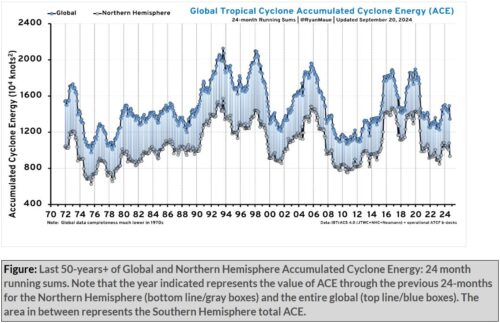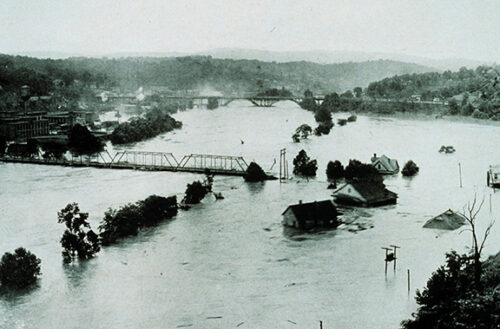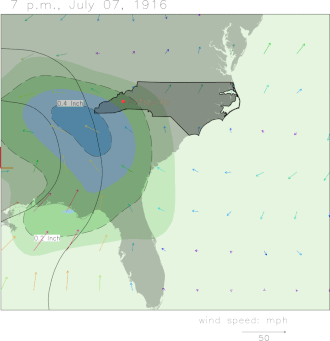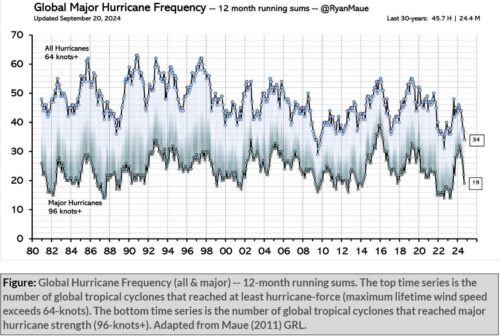Climatologist: Media, FEMA Use Hurricane Helene To Stoke Climate Fears, Ignore Natural Cycles
Climatologist: Media, FEMA Use Hurricane Helene To Stoke Climate Fears, Ignore Natural Cycles
Dr. Matthew Wielicki
As I watched the devastation caused by Hurricane Helene, the homes submerged, lives upended, and entire communities left in disarray, my heart went out to those facing unimaginable loss. It’s a stark reminder of the human cost of these natural disasters. [emphasis, links added]
But as we confront these tragedies, we must also take a critical look at how we respond to them. Are we truly addressing the causes, or are we caught in a cycle of rebuilding in the same vulnerable areas, only to see them destroyed again?
The recent Hurricane Helene has sparked renewed debate about the relationship between extreme weather and climate change.
FEMA Administrator Deanne Criswell’s remarks, focusing on warming waters and rising storm intensities, reflect the narrative that connects these disasters to global climate trends.
However, the available data on hurricane frequency and historical comparison with the 1916 Appalachian storm complicate this picture and raise questions about how we should respond to such disasters.
Analysis of Administrator Criswell’s Statements
In her recent CBS interview, Administrator Criswell stated that the rapid intensification of recent hurricanes, including Helene, is largely due to the warming waters of the Gulf of Mexico. She suggested that these conditions are fueling more frequent and powerful storms.
ADMINISTRATOR CRISWELL: Well, I think what we’re seeing, Robert is, you know, this storm took a while to develop, but once it did, it developed and intensified very rapidly, and that’s because of the warm waters in the Gulf and so it’s creating more storms that are reaching this major category level than we’ve seen in the past. It’s also creating greater amounts of storm surge in the coastal areas. It’s creating greater amounts of rainfall as it moves up north. And so in the past, when we would look at damage from hurricanes, it was primarily wind damage, with some water damage, but now we’re seeing so much more water damage, and I think that is a result of the warm waters, which is a result of climate change.
This view, heavily endorsed by both policymakers and some scientists, asserts that human-driven climate change is the root cause of these escalating natural disasters.
However, historical and meteorological data offer a more complex picture.
Despite increasing atmospheric CO2 levels, the frequency of major hurricanes (≥ 96 knots) has fluctuated over time, following a cyclical rather than linear trend.
Meteorologist Dr. Ryan Maue’s data on the 12-month running sums of global hurricane frequency reveals periods of both increases and decreases over the last several decades, questioning the assertion that climate change is the sole or even primary driver behind these storms.
While the number of hurricanes is often used to discuss the impacts of climate change, the frequency of storms does not necessarily indicate whether storms are becoming more intense.
To assess whether hurricanes are becoming stronger, a more reliable metric is Accumulated Cyclone Energy (ACE), which considers both the duration and intensity of tropical storms and hurricanes.
The provided graphic of global and Northern Hemisphere ACE data over the last 50 years illustrates no significant upward trend in cyclone energy.
In fact, the data suggest periods of fluctuation but no consistent increase in storm strength. This implies that while storms like Hurricane Helene might be destructive, there is no clear evidence that climate change is “supercharging” the entire hurricane system.
ACE remains a crucial tool in understanding storm power, showing that variability in storm energy, rather than a dramatic intensification, is part of the natural system.

Comparing Hurricane Helene and the 1916 Storm
To provide historical context, it’s essential to compare Hurricane Helene with the 1916 storm that devastated Appalachian towns.
The flood of July 1916 in Asheville, North Carolina, was caused by two back-to-back tropical systems that dumped unprecedented rainfall on the region.
This resulted in the most catastrophic flooding in Western North Carolina’s history. The flood stage at the French Broad River in Asheville reached an astonishing 21 feet, with water levels rising rapidly due to the saturated ground and overwhelming rivers and streams.
This flood submerged entire sections of Asheville [pictured above, below], destroyed homes, businesses, and railroads, and left significant debris in its wake.

Several towns in the Appalachian region experienced unprecedented destruction, with many areas submerged under several feet of water.
The 1916 storm caused rivers like the Swannanoa to rise over their banks, affecting communities that had little in terms of flood infrastructure.

The total economic toll and loss of life were profound, as the region struggled to recover from the devastation.
The 1916 event occurred even though atmospheric CO2 levels were approximately 120 ppm lower than they are today.

In comparison, Hurricane Helene caused flooding in Asheville just recently. While the exact numbers may not be finalized yet, NOAA shows that the French Broad River at Asheville reached a peak stage of 24.67 feet following Hurricane Helene.
This crest exceeds the 1916 flood level, which had reached a record of 23.1 feet. This new peak is indicative of the storm’s severity and the risk of significant flooding in the region.

The 1916 event suggests that extreme weather events of similar magnitude occurred long before human-driven climate change became a prominent factor.
Hurricanes are a natural part of Earth’s climatic system, and their occurrence is influenced by a wide range of factors, including natural climate variability and oceanic patterns.
The comparison between these two storms highlights an important point: while the frequency and intensity of hurricanes may fluctuate, they are not unprecedented.
The 1916 storm serves as a reminder that catastrophic weather events have always occurred and will continue to do so, regardless of human activity. This context raises questions about how we should interpret and respond to current events like Hurricane Helene.
Irrational Fear is written by climatologist Dr. Matthew Wielicki and is reader-supported. If you value what you have read here, please consider subscribing and supporting the work that goes into it.
Read rest at Irrational Fear

